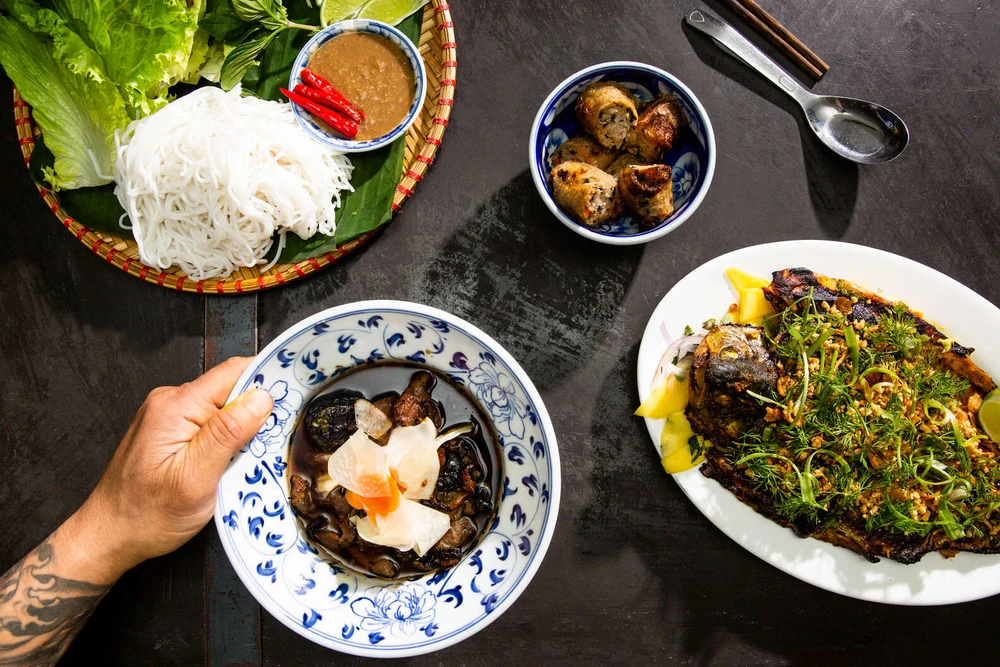
When it comes to Vietnamese food, most people immediately think of two things: pho and banh mi. It makes sense. Pho, the aromatic noodle soup, is widely considered to be Vietnam’s national dish. Banh mi—the flavor-packed oblong sandwiches filled with things like pickled carrots, chargrilled pork, and liver pâté—is inexpensive and delicious.
But just as Mexican food is comprised of more than tacos, and Japanese food is so much than sushi, Vietnamese food is also made of more than pho and banh mi. How much more, do you ask? From noodle soups and beef stew, to rice cakes and epic fish preparations, these dishes can be found at exciting Vietnamese restaurants around the country like Hanoi House and Madame Vo. Here are 10 dishes you need to order ASAP.
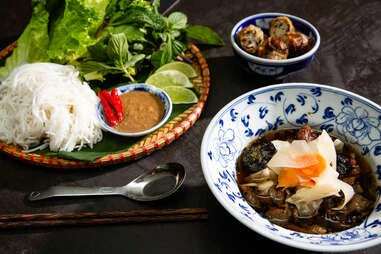
Bun Cha Hanoi
Pronunciation guide:boon-chah-hah-noy
This is the dish that Anthony Bourdain introduced President Obama to during the Hanoi episode of his CNN TV show, Parts Unknown, and it's one you should introduce to your lunch or dinner plans, too.The dish consists of slider-sized, mini ground pork patties steeped in a diluted sweet and savory fish sauce. Served with rice vermicelli noodles on the side, and a plate of lettuce and herbs, bun cha (“bun” means rice vermicelli; “cha” is the pork patty), is essentially a deconstructed version of the popular chargrilled pork and noodle bowl known as bun thit nuong. In Hanoi, it is simply called “bun cha,” but everywhere else, Hanoi is added to name of the dish to indicate its origin. To eat it, you assemble noodles, vegetables, and meat in small batches, drizzling a bit of fish sauce in the bowl to your taste, and slurping up the noodles and veg in between bites of pork. It takes some effort, and can get a bit messy, but the the interplay of crisp, fresh veggies, springy, rice noodles and smoky, charred pork is fantastic, and the ad hoc assembly means that no two bites are the same.
Bo kho
Pronunciation guide: baw-khaw
Available on breakfast, lunch and dinner menus, bo kho is the Vietnamese version of France's boeuf bourguignon. Made with beef shank and tendon that are stewed in a lemongrass and five-spice-scented broth, the simple dish is typically served with a loaf of just-toasted, plain banh mi bread on the side. To eat it, tear up the bread into small pieces and dip it in the sauce, before lapping it up with a bite of fork-tender meat and carrot. Bo kho is also available as a noodle soup. Served with chewy rice noodles, the dish is called hu tieu bo kho. Served with thin egg noodles, the dish is called mi bo kho. Pro tip: When ordering a bo kho noodle soup, get a side order of bread for dipping.
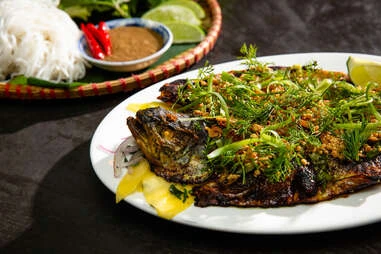
Cha ca
Pronunciation guide: chah-cah
Another famous dish from the northern Vietnamese capital of Hanoi, cha ca is a dish of grilled white fish chunks marinated in turmeric and galangal (an aromatic root herb, similar to ginger), served with fresh dill, rice vermicelli, peanuts, and crispy puffed rice paper, called banh da. The components come separately, requiring assembly at the table. Start by adding the rice vermicelli to your bowl, topping it with the dill, peanuts, and breaking up the puffed rice paper into small bite-sized pieces. Drizzle some mam tom (fermented shrimp paste) and pineapple sauce over everything. Then, mix it all up before eating, alternating between bites of seasoned noodle and fish as you go along. The sauce imparts a deep, pungent funk to the dish thanks to the fermented shrimp base, but then, that’s what makes it so good.
Banh beo chen
Pronunciation guide: bang beh-oh chan
Fun to eat and totally Instagrammable, banh beo chen are delicious steamed glutinous rice cakes (banh beo) served in little round saucers (chen). Traditionally an afternoon snack or appetizer dish, it’s now commonly eaten ordered as a lunch or dinner entree for one. Topped with some variation of crispy pork fat and/or pork skin, minced shrimp and fried shallot, the cakes are usually served in a tray of 9 to 12 little saucers, with a small metal spoon and a bowl of mild, sweet and savory nuoc mam pha (mixed fish sauce). To eat, pour a spoonful of sauce over the cake, use the metal spoon to loosen the edges, and then plop the entire cake into your mouth.

Bun bo Hue
Pronunciation guide: boon boh hway
With dollops of red oil floating on top and chunks of huyet (congealed pork blood), pork hocks, peppery Vietnamese beef sausage, and sliced beef shank as toppings, bun bo Hue is definitely meaty. It also might seem a bit daunting. But if you are willing to to dive tongue first into this spicy soup—a specialty of the Imperial city of Hue in the central region of Vietnam—you might never want to eat anything else. Served with thick, udon-like noodles, the broth is simmered for hours with lemongrass and other spices, yielding a robust, full-bodied, umami-laden flavor-bomb for a meal that is unparalleled.
Banh cuon
Pronunciation guide: bang kwuhn
A Northern Vietnamese speciality that translates to "rolled cake," banh cuon are made from steamed, translucent rice noodle rolls that are served either plain (banh cuon thanh tri), filled with ground pork and wood ear (banh cuon nhan thit), or stuffed with shrimp (banh cuon tom). Delicate and slightly glutinous in texture, the rolls made from the thinnest noodles are the most coveted. Served with blanched bean sprouts and slices of gio, a Vietnamese pork cold cut similar to bologna, they come with a nuoc mam cham for dipping. It's typically eaten during breakfast or lunch, but if you sneak a few for dinner we won't tell.
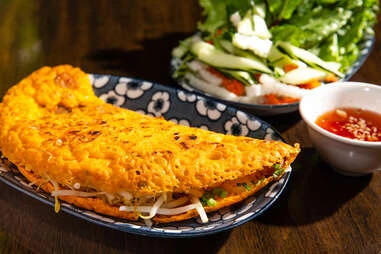
Banh Xeo
Pronunciation guide: bang seh-oh
Made from rice flour flavored with turmeric and coconut milk, banh xeo, which means “sizzling cake” is the Vietnamese version of a savory French crepe. Filled with bean sprouts, sliced pork belly, and shrimp, this Southern Vietnamese dish can be ordered as either an appetizer to share, or as a main dish. Light and delicate, with textures reminiscent of Japanese tempura, the dish is best when dipped it in a sweet and savory nuoc cham fish sauce.
Bun rieu
Pronunciation guide: boon rhee-eww
This dish is built for crab fanatics. A rice vermicelli noodle soup made with tomato and crab, bun rieu is one of Northern Vietnam’s most popular and recognizable meals. Originating in the Red River Delta, both the broth and topping are both made from rice paddy crabs that have been pounded into a paste. The paste and juices are cooked with tomato until these curdled crab patties float at the top. The result is a tangy and savory soup teeming with crab essence. At its most basic, the dish comes topped with the crab and a smattering of green onion and cilantro for freshness. Fancier versions include cubes of fried tofu and congealed blood cubes, or huyet. Another variation on this dish is bun rieu oc, which comes with crispy and chewy escargot.
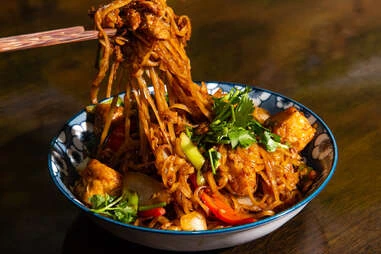
Mi, hu tieu, or pho kho
Pronunciation guide: mee, hoo tee-oh, fuh khoh
Most Vietnamese restaurants that serve noodle dishes also frequently offer an option to order the dishes “kho,” or dry. This means that the noodles are served in a bowl separate from the broth. While not all noodle dishes can be ordered this way, the most common ones—mi (egg noodle), hu tieu (chewy rice noodle), and pho ga (chicken pho)—can. Great for hot days when you don’t want to sweat from eating something with steaming hot broth, the kho version of these noodle soups also benefit from a special sauce—usually a sweet and savory brown sauce made with sugar, oyster sauce and soy sauce—that is poured over the dry noodle to give it an extra umami boost.
Ca kho to
Pronunciation guide:cah khaw toh
One of the typical dishes that make up a Southern Vietnamese family meal, ca kho to is a dish of caramelized fish filet in clay pot. Sweet and salty and bursting with umami, the fish is meant to be eaten with rice, and is often ordered in conjunction with canh ca chua, a tamarind-based sweet-and-savory fish soup. Vietnamese restaurants specializing in com phan, or family meal, will serve it as part of a set menu for two people or more.




















